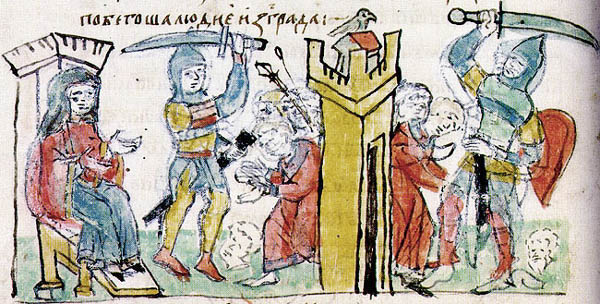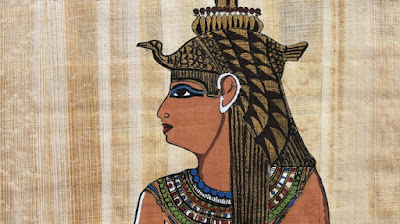Princess Olga of Kiev

Princess Olga of Kiev is viewed as the absolute most vicious and ferocious rulers in the history of the
Kievan Rus (a loose federation of East Slavic tribes that existed from the late 9th century to the mid-13th century, under the Rurik Dynasty). Olga was born in 890; with no solid evidence of her place of birth, Emily Upton of
Today I Found Out: Feed Your Brain, places her birth in either
Pskov, or
Veshchy.
Pskov is the more reliable location of Olga's birth, because in addition to Emily Upton, according to the "Prominent Russians: Princess Olga of Kiev" article, the author places her birth in
Pskov, as well. Much of Olga's upbringing is practically unknown; the earliest event that happened to Olga after her birth, that we know of, is her marriage to Prince Igor sometime before 912. Because in 1912, Olga and Igor became rulers of the
Kievan Rus after the death of the previous ruler, Oleg Veshchy
.

Olga's story continues to stagger throughout, because the next event we have to is the birth of her child, Svyatoslav, in 1942. Following the three years that passed after that, in 1945, Prince Igor took a trip to the Slavic tribe of the
Drevlyans to gather tributes. After he demanded a higher payment than we they gave him, the
Drevlyans took matters into their own hands and killed the prince. Following the death of Prince Igor, according to the article "Prominent Russians: Princess Olga of Kiev," the question was raised to see who would become the next ruler. Technically, the next in line was her son, Svyatoslav. However, he was only three-years-old. Due to all these unforeseen events Olga took matters into her own hands and became the ruler of the
Kievan Rus, this was going to be Olga's regency. According to the article "Prominent Russians: Princess Olga of Kiev," she had the full support of the Rus army - attesting to the amazing respect she held among people.
Olga did take lightly the account of her husband's death. She never once subdued her feelings about the situation, because what follows is an absolute bloodbath of events.
According to the "Russian Primary Chronicle," there are a total of four different acts of vengeance that Olga had followed through with against the
Derevlians (a different spelling for
Drevlyans, within the Russian Primary Chronicle). The four vengeances occurred as followed:
1.) Once the
Derevlians found out about the new female ruler, they sent 20 of their ambassadors (matchmakers) to negotiate a marriage between their prince, Prince Mal and Olga. Once the 20 ambassadors arrived in Kiev, Olga had them return to their ships for the night so she could be able to have her people's presence present. She had even given them the opportunity to be carried back into the city within their boats. Once they had left, Olga had a deep ditch dug out, and when her people were carrying them into the city the following morning, they had dropped the
Derevlians in the ditch along with the boat. She then ordered them to be buried alive.
2.) Princess Olga then asked the
Derevlians to send their finest ambassadors, to which she would be able to go to their Prince with such honor. The
Derevlians did send more ambassadors, once they arrived, they were asked to only appear to Olga after they have bathed. The bathhouse was heated, and once the ambassadors entered they were locked in, and the bathhouse was set on fire.
3.) Princess Olga then decided to go to the
Derevlians for the chance to mourn over her husband's grave. She also ordered for large quantities of mead to be made for her arrival. Once she arrived, she went to her husband's grave and mourned. She then ordered for there to be a funeral feast in honor of her husband. Once the
Derevlians were drunk, Olga and her followers slaughtered 5,000 of them. Olga returned to Kiev to prepare an army to kill the survivors.
4.) The surviving
Derevlians offered Princess Olga honey and furs, as a treaty. However, Princess Olga knew they had neither of the sorts, so she then asked for three pigeons and three sparrows from every home. Once she was given all the pigeons and sparrows, she told the
Derevlians she would leave their city the following day. She then gave everyone in her army a pigeon, or a sparrow, and tied a piece of sulfur bound in cloth. She had the birds released at night and once they birds flew back to every home, everything was set on fire. Nothing was safe from the flames; the survivors from the conflagration were either killed by her army, or given as slaves to her followers.
Needless to say, you do not want to anger Princess Olga of Kiev. She is a powerful, revenge-driven woman, who speaks volumes to the culture shock of having a woman as a leader. She thrived in a time where blood and war were a constant routine. According to Emily Upton, one would think it'd be strange to see such a vengeful woman convert the
Kievan Rus from a pagan society, to Christianity, be baptized sometime between 945 and 957, and turn into a saint in Roman Catholicism, and Russian Orthodoxy.
She even has a monument dedicated to her in the present day in Mihaylovskaya square in Kiev; her statue is raised higher than the other three men who have statues next to hers: Apostle St. Andrew the First-Called, and the enlighteners Cyril and Methodius.
Through the madness that is her life, Princess Olga passed away in the year of 969. Her efforts were never forgotten, because in 1547 she was declared a saint by the Orthodox Church. According to Emily Upton, she is called, "isapostolos," meaning, "equal to the apostles". She is one out of five women who have had the honor of this status in the history of Christianity, and Princess Olga of Kiev deserves every single recognition possible.
Sources:
"Prominent Russians: Princess Olga of Kiev." Russiapedia, Russiapedia (Get to Know Russia Better), russiapedia.rt.com/prominent-russians/history-and-mythology/princess-olga-of-kiev/.
"Russian Primary Chronicle."
Upton, Emily. "The Saint Who Buried People Alive and Burned Down a City in Revenge." Today I Found Out, Today I Found Out: Feed Your Brain, 27 Jan. 2014, www.todayifoundout.com/index.php/
2014/01/saint-buried-people-alive-burned-city-revenge/.
 Joan of Arc was born in 1412 to two tenant farmers in a small village located in Domrey, France.
Joan of Arc was born in 1412 to two tenant farmers in a small village located in Domrey, France. 




























